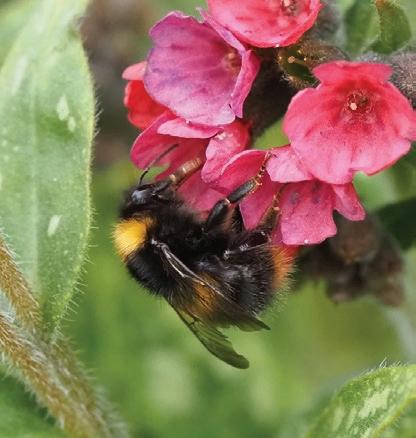
3 minute read
References
The Supporter Agreement on page 62 refers to Target 6.4; Action 179: Maintain a network of organisations who agree to help promote or otherwise assist the All-Ireland Pollinator Plan. Organisations can sign up as a supporter of the Plan using the framework and indicate what specific actions they are willing to take in support.
1Nieto, A., et al., European Red List of Bees. 2015: IUCN.
Advertisement
2IPBES, The assessment report of the Intergovernmental Science-Policy Platform on Biodiversity and Ecosystem Services on pollinators, pollination and food production., ed. S.G. Potts, V.L. Imperatriz-Fonseca, and H.T. Ngo. 2016, Bonn, Germany: Secretariat of the Intergovernmental Science-Policy Platform on Biodiversity and Ecosystem Services.
3Fitzpatrick, Ú., et al., Regional Red List of Irish bees. 2006: National Parks and Wildlife Service, Department of the Environment, Heritage and Local Government, Ireland.
4Powney, G.D., et al., Widespread losses of pollinating insects in Britain. Nature Communications, 2019. 10(1): p. 1018.
5Ollerton, J., et al., How many flowering plants are pollinated by animals? Oikos, 2011. 120(3): p. 321-326.
6Klein, A-M., et al., Importance of pollinators in changing landscapes for world crops. Proc. R. Soc., 2007. 274(1608): p. 303–313.
7Williams, I.H., The dependence of crop production within the European Union on pollination by honey bees. Agricultural Zoology Reviews, 1994. 6: p. 229-257.
8UNEP, UNEP Emerging Issues: Global Honey Bee Colony Disorder and Other Threats to Insect Pollinators. 2010: United Nations Environment Programme.
9Leonhardt, S.D., et al., Economic gain, stability of pollination and bee diversity decrease from southern to northern Europe. Basic and Applied Ecology, 2013. 14(6): p. 461-471.
10Stout, J.C., et al., Assessing Market and Non-market Values of Pollination Services in Ireland (Pollival), in Environmental Protection Agency Research Report. 2019, Environmental Protection Agency: Johnstown Castle, Co. Wexford, Ireland.
11Wratten, S.D., et al., Pollinator habitat enhancement: Benefits to other ecosystem services. Agriculture, Ecosystems & Environment, 2012. 159(0): p. 112-122.
12Dainese, M., et al., A global synthesis reveals biodiversitymediated benefits for crop production. Sci Adv, 2019: p. 554170. 13Woodcock, B.A., et al., Meta-analysis reveals that pollinator functional diversity and abundance enhance crop pollination and yield. Nature Communications, 2019. 10(1): p. 1481.
14Isbell, F., et al., The biodiversity-dependent ecosystem service debt. Ecology Letters, 2015. 18(2): p. 119-134.
15Becerra, G. and E. Underwood, A review of Member States’ initiatives to support wild pollinator populations. 2020: https://wikis.ec.europa.eu/display/EUPKH/ Actions+in+my+country.
16Wilson, J.S., et al., Interest exceeds understanding in public support of bee conservation. Frontiers in Ecology and the Environment, 2017. 15(8): p. 460-466.
17Baldock, K.C.R., Opportunities and threats for pollinator conservation in global towns and cities. Current Opinion in Insect Science, 2020. 38: p. 63-71.
18European Court of Auditors, Protection of wild pollinators in the EU — Commission initiatives have not borne fruit. 2020: Luxembourg.
19Goulson, D., et al., Bee declines driven by combined stress from parasites, pesticides, and lack of flowers. Science, 2015. 347: p. 1255957.
20Hassett, J., et al., A significant pure population of the dark European honey bee (Apis mellifera mellifera) remains in Ireland. Journal of Apicultural Research, 2018. 57(3):337350.
21Browne, K.A., et al., Investigation of free-living honey bee colonies in Ireland. Journal of Apicultural Research, 2020. 10.1080/00218839.2020.1837530.
22Regan, E.C., et al., Ireland Red List No.4: Butterflies. 2010: National Parks and Wildlife Service, Department of the Environment, Heritage and Local Government, Ireland.
23Allen, D., et. al., Ireland Red List No. 9: Macro-moths (Lepidoptera). 2016: National Parks and Wildlife Service, Department of Arts, Heritage and the Gaeltacht, Dublin, Ireland.
www.pollinators.ie
Implementation of the All-Ireland Pollinator Plan is coordinated by the National Biodiversity Data Centre.
Suggested citation: All-Ireland Pollinator Plan 2021-2025. National Biodiversity Data Centre Series No. 25, Waterford. March 2021.
Funding for design of this booklet has been provided by the Department of Agriculture, Food and the Marine.
Thanks to botanical artist, Shevaun Doherty, for the painting on the front cover – of the Garden bumblebee (Bombus hortorum) on Knapweed.

The National Biodiversity Data Centre is a programme of the Heritage Council and is operated under a service level agreement by Compass Informatics. The Biodiversity Data Centre is funded by the Heritage Council and the Department of Housing, Local Government and Heritage.










